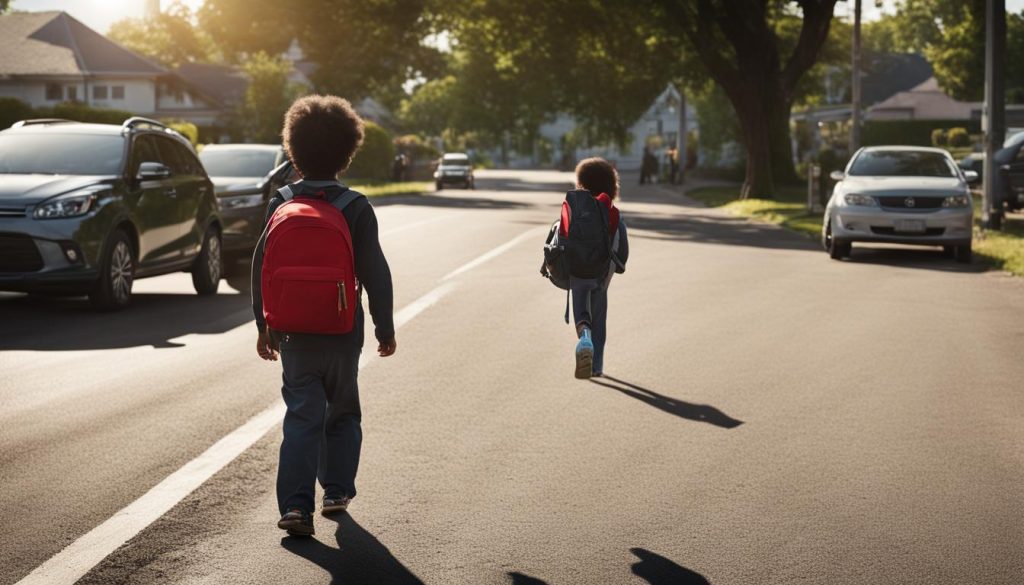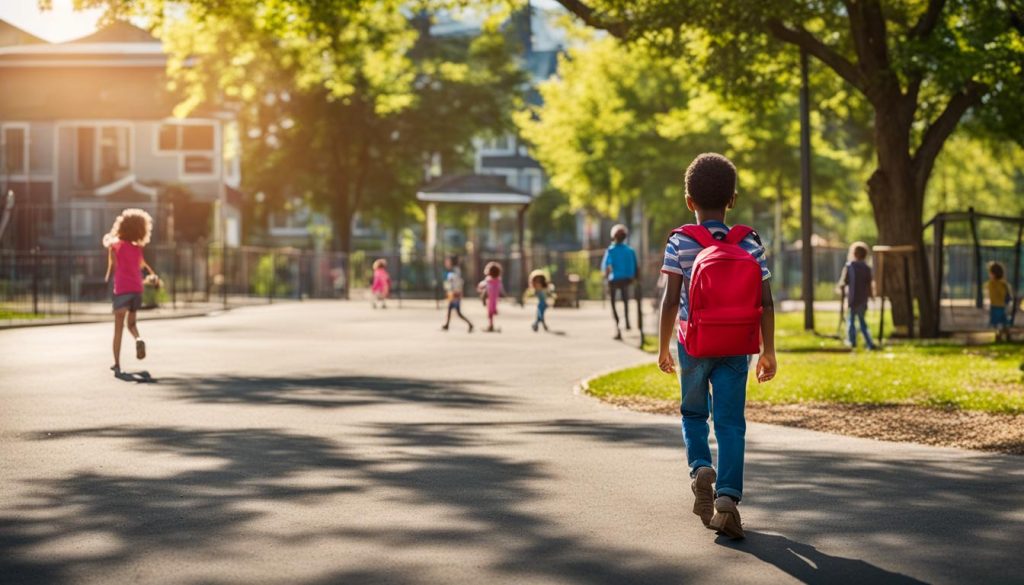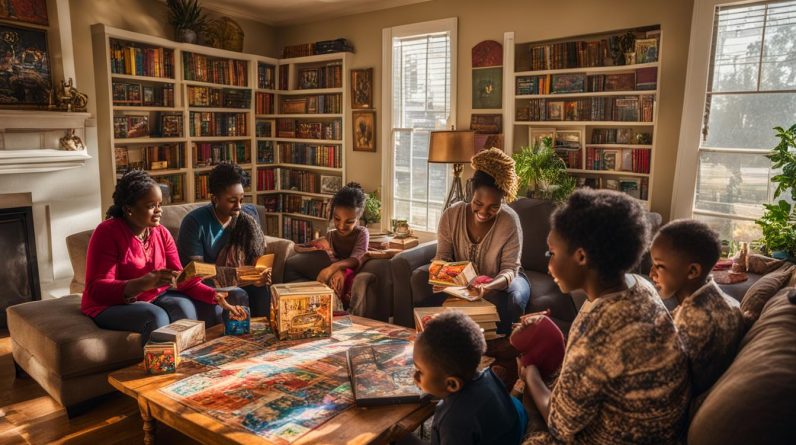Are you wondering at what age it’s safe for your child to start walking home from school alone? Let’s explore the legal considerations, child safety guidelines, and factors to consider when making this decision.
In the United States, there is no specific federal minimum age set for children to walk home from school alone. Instead, the responsibility of establishing guidelines falls upon individual states, school districts, and parents. When determining if a child is ready to walk home alone, factors such as maturity and responsibility, distance and route, traffic conditions, weather conditions, and local laws and regulations should be considered.
While most states do not specify an age, some states have minimum ages ranging from 8 to 14 years old. It’s essential for parents to evaluate their child’s readiness and ensure their safety when allowing them to walk home from school alone.
Key Takeaways:
- There is no specific federal minimum age for children to walk home from school alone in the United States.
- Parents should consider factors such as maturity, distance, traffic conditions, and local laws when deciding if their child is ready.
- Some states have established minimum ages, but most leave the decision up to parents.
- Evaluating a child’s readiness and ensuring their safety are crucial when allowing them to walk home alone.
- Stay informed about state-specific laws and guidelines to ensure compliance and safety.
Federal Guidelines and Recommendations
When it comes to children walking home from school alone, there are no specific federal guidelines or legal requirements set in place. The responsibility of determining the appropriate age primarily falls on individual states, school districts, and parents. While there is no federal minimum age, it is essential for parents to consider various factors before allowing their child to walk home alone. Evaluating a child’s maturity and responsibility is crucial to ensure their safety during the journey.
| Factors to Consider | Explanation |
|---|---|
| Maturity | Assess your child’s ability to make responsible decisions and handle unexpected situations. |
| Responsibility | Consider whether your child can follow safety rules, understand pedestrian etiquette, and react appropriately to potential hazards. |
| Distance and Route | Evaluate the length of the walking route and ensure it is safe, well-lit, and free from potential dangers. |
| Traffic Conditions | Take into account the traffic volume, speed limits, crosswalks, and any challenging intersections along the route. |
| Weather Conditions | Consider how various weather conditions may impact your child’s safety, such as heavy rain, snow, or extreme heat. |
| Local Laws and Regulations | Research any specific laws or regulations in your state or municipality regarding the minimum age for children walking home alone. |
While federal guidelines do not exist, it is important for parents to prioritize their child’s safety and make informed decisions based on these factors. By evaluating readiness and considering the specific circumstances, parents can ensure a safe and independent journey for their child.
Overview of State Laws on Minimum Ages
Each state in the USA has its own set of laws and guidelines regarding the minimum age for a child to walk home from school alone. While most states do not specify an age and leave the decision up to parents, some states have established minimum ages between 8 and 14 years old. It is important for parents to familiarize themselves with the laws in their specific state to ensure compliance and the safety of their child.
| State | Minimum Age for Child to Walk Home Alone |
|---|---|
| California | No specified minimum age; up to parent’s discretion |
| Texas | No specified minimum age; up to parent’s discretion |
| New York | No specified minimum age; up to parent’s discretion |
| Florida | Age 10 or older |
| Illinois | Age 14 or older |
| Pennsylvania | Age 8 or older |
Factors to Consider for Parents Making the Decision
When deciding if your child is ready to walk home from school alone, there are several important factors to consider. Keep in mind that every child is different, so it’s essential to evaluate their individual needs and capabilities. By taking these factors into account, you can make an informed decision that ensures their safety and well-being.
The child’s maturity level
One of the primary considerations is your child’s level of maturity. Are they responsible and able to follow rules independently? Can they handle unexpected situations and make safe decisions? Assessing their cognitive and emotional development will help determine if they can navigate the potential challenges of walking home alone.
The distance and route from school to home
Take into account the distance your child needs to walk and the route they will take. Is it a manageable distance for their age? Consider the presence of sidewalks, crosswalks, and pedestrian-friendly infrastructure. If the route involves busy streets or hazardous areas, you might want to explore alternative transportation options.
Traffic conditions along the route
Examine the traffic patterns in the area where your child will be walking. Is it a high-traffic zone during the time they’ll be walking? Evaluate the speed limits and the behavior of drivers in the area. Ensure that your child understands and can confidently navigate road crossings and intersections safely.
Weather conditions
Weather can be unpredictable and affect your child’s safety while walking home. Consider factors such as extreme heat, heavy rain, snow, or low visibility due to fog. Determine if your child is equipped with appropriate clothing and accessories, such as reflective gear or umbrellas, to handle varying weather conditions.
Local laws or regulations regarding walking home alone
Research the local laws and regulations in your area pertaining to children walking home alone. Some jurisdictions may have specific age restrictions or guidelines for when a child can be unsupervised. Familiarize yourself with these regulations and ensure you are compliant with the legal requirements.
Open communication and addressing concerns
Engage in open and honest communication with your child about their comfort level and any concerns they may have about walking home alone. Encourage them to express their fears or anxieties and provide reassurance and guidance. By addressing their concerns, you can help alleviate any potential worries and ensure their confidence and readiness for this responsibility.

Steps to Take for Safety
Before allowing your child to walk home from school alone, it is important to take certain steps to ensure their safety. By following these precautions, you can feel confident in your child’s well-being while promoting their independence.
- Walk the route together: Take the time to walk the route with your child multiple times. This will help them become familiar with their surroundings and identify any potential hazards along the way.
- Set clear rules and check-in procedures: Establish clear rules for your child to follow, such as staying on the designated route, not talking to strangers, and being responsible with personal belongings. Create a check-in procedure where your child contacts you upon arrival home to ensure their safe arrival.
- Emergency preparedness: Ensure your child knows what to do in case of emergencies. Teach them how to handle situations such as getting lost, encountering unfamiliar dogs, or encountering strangers. Provide them with a cellphone or a means to contact you or emergency services if needed.
- Consider alternatives: If you have concerns about your child walking alone, consider alternatives such as walking in groups with other children from the same neighborhood or utilizing transportation services provided by the school or community.
By taking these steps, you can help ensure your child’s safety while instilling confidence in their ability to navigate their way home.
Benefits of Kids Walking to School Alone
Allowing kids to walk home from school alone can have several benefits. It provides them with physical exercise and fresh air, helping to improve their overall health and well-being. Walking also encourages children to take responsibility for themselves and develop a sense of independence. By navigating the route to and from school, they learn valuable life skills such as time management and problem-solving.
Walking to school independently can also have a positive impact on a child’s academic performance. Research suggests that physical activity before school can improve focus, attention, and cognitive function, leading to better academic outcomes. Additionally, walking provides an opportunity for children to engage with their surroundings and develop a sense of curiosity and wonder, which can enhance their learning experience.
Benefits of Kids Walking to School Alone:
- Physical exercise and fresh air: Walking promotes physical activity and provides children with an opportunity to engage in moderate exercise, contributing to a healthy lifestyle.
- Independence and responsibility: Walking alone fosters independence and helps children develop a sense of responsibility by taking care of themselves during their journey to and from school.
- Improved academic performance: Walking before school can enhance cognitive function and attention, leading to improved academic performance.
- Promotes happiness and relaxation: Walking in nature or simply enjoying a leisurely stroll can have a positive impact on mental well-being, promoting happiness and relaxation.
- Teaches time management: Walking to school requires children to plan their time effectively, helping them develop essential time management skills.
Overall, allowing children to walk home from school alone can empower them, foster a sense of accomplishment, and contribute to their personal growth. While there are risks to consider, such as traffic safety, parents can mitigate these risks through proper education, communication, and supervision when necessary.
| Benefits of Kids Walking to School Alone |
|---|
| Physical exercise and fresh air |
| Independence and responsibility |
| Improved academic performance |
| Promotes happiness and relaxation |
| Teaches time management |

The Recommended Age for Kids Walking to School Alone
According to the American Academy of Pediatrics, it is generally recommended that kids are not ready to walk to school alone until about fifth grade or around age 10. However, it is important to consider various factors when determining a child’s readiness to walk home alone.
Factors such as the child’s maturity level, sense of direction, sense of safety, and ability to communicate play a significant role in their readiness to walk home alone. It is essential to assess these factors and make an informed decision based on the child’s individual capabilities.
Additionally, factors such as the distance and types of roads on the route should be taken into consideration. Children may be ready to walk home alone at different ages depending on the specific circumstances of their route.
By evaluating these factors and considering the child’s readiness, parents can make a decision that promotes their child’s safety and independence.
Factors to Consider for Assessing a Child’s Readiness:
- Maturity level
- Sense of direction
- Sense of safety
- Ability to communicate
- Distance and types of roads on the route
Assessing a child’s readiness to walk home alone is a crucial step in ensuring their safety and well-being. By considering these factors, parents can make an informed decision that aligns with their child’s capabilities and fosters their independence.
| Factors to Consider | Recommended Age Range |
|---|---|
| Maturity Level | Around fifth grade or age 10 |
| Sense of Direction | Around fifth grade or age 10 |
| Sense of Safety | Around fifth grade or age 10 |
| Ability to Communicate | Around fifth grade or age 10 |
| Distance and Types of Roads on the Route | May vary depending on the circumstances |
Assessing a child’s readiness for walking home alone is not solely determined by age but rather a combination of factors. It is important for parents to evaluate their child’s capabilities and make an informed decision that prioritizes their safety and well-being.

Signs a Child Isn’t Ready to Walk Home Alone
Even if your child meets the recommended age to walk home from school alone, it’s important to recognize that readiness varies from child to child. There are specific signs that may indicate your child isn’t quite ready for this level of independence. Pay attention to their behavior and consider the following signs:
- Easily Getting Distracted: If your child tends to get easily distracted or loses focus while walking or crossing the street, it may signify a lack of attention to their surroundings.
- Not Remembering to Look Before Crossing: A child who consistently forgets to look both ways before crossing the street might not have developed the necessary road safety awareness and judgment.
- Feeling Uncomfortable or Unwilling to Walk Alone: It’s crucial to listen to your child’s feelings about walking home alone. If they express discomfort or resistance, it may indicate that they are not ready to tackle this responsibility.
It’s essential for parents to trust their instincts and consider these signs when making a decision about their child’s readiness for walking home alone. Every child develops at their own pace, so it’s important to assess their maturity, responsibility, and confidence before allowing them to take on this independent journey.

Remember, the safety and well-being of your child should always be the top priority.
Preparing a Child for Walking Home Alone
Before allowing your child to walk home from school alone, it is crucial to take the necessary steps to prepare them for this journey. By teaching them important safety precautions and empowering them with knowledge, you can ensure their well-being and instill confidence in their ability to navigate the route independently.
- Emphasize the importance of not getting in a car with strangers: Teach your child to never accept rides from individuals they don’t know, no matter how friendly they may seem. Encourage them to always prioritize their safety and stay vigilant.
- Walk on sidewalks and use crosswalks: Remind your child to stick to designated sidewalks and use crosswalks whenever available. This will help them stay visible to drivers and reduce the risk of accidents.
- Make eye contact with drivers: Teach your child to make eye contact with drivers before crossing the street. This ensures that the driver acknowledges their presence and helps prevent any miscommunication.
- Be alert for traffic and potential dangers: Encourage your child to pay attention to their surroundings at all times. Help them understand the importance of looking both ways before crossing the street, being cautious at intersections, and staying away from potentially hazardous situations.
Role-playing scenarios and doing trial runs can be effective ways to prepare your child for different situations they may encounter. By rehearsing potential scenarios, such as encountering a stray animal or an unfamiliar adult, you can help them develop the necessary problem-solving skills and build confidence in their ability to handle unexpected situations.
By implementing these safety precautions and providing your child with the knowledge they need, you can prepare them for walking home alone and ensure their safety throughout the journey.
Risks and Benefits of Kids Walking to School Alone
Walking to school alone can be both a rewarding experience and a source of concern for parents. It is important to consider the risks and benefits when deciding if your child is ready to take this step towards independence.
Risks of Child Walking Home Alone
While there is a potential for danger, implementing safety precautions can help mitigate the risks:
- Traffic hazards: Teach your child about road safety, including looking both ways before crossing, using crosswalks, and avoiding distractions like electronic devices.
- Stranger danger: Educate your child about potential risks posed by strangers and how to respond to unfamiliar individuals. Encourage them to walk with friends or in groups whenever possible.
- Weather conditions: Prepare your child for various weather situations, such as extreme heat, cold, rain, or snow, and ensure they have appropriate clothing and accessories for protection.
- Unsafe areas: Familiarize yourself with the route your child will take and identify any areas that may pose safety concerns. Consider alternative paths or transportation options if necessary.
Remember, it’s crucial to assess your child’s readiness and make informed decisions based on their individual capabilities. Open communication and ongoing evaluation are key to ensuring their safety.
Benefits of Child Walking Home Alone
Despite the risks, there are several benefits to allowing your child to walk home from school:
- Increased physical activity: Walking can help your child stay active and maintain a healthy lifestyle.
- Improved academic performance: Studies have shown that physical activity before and after school can enhance cognitive function and academic performance.
- Development of independence and responsibility: Walking home alone can foster a sense of independence and teach your child valuable life skills.
- Relaxation and happiness: Walking can provide a sense of relaxation and freedom from the stresses of the school day.
- Better time management skills: Walking home requires your child to manage their time effectively and arrive home on schedule.
These benefits can contribute to your child’s overall growth and development, helping them become more self-reliant and confident individuals.
Remember, the decision to allow your child to walk home from school alone should be carefully considered, taking into account their personal readiness and the necessary safety precautions.
Handling Safety Concerns as a Grandparent
As a concerned grandparent, you may have questions and worries about your grandchild walking home from school alone. It’s natural to want to ensure their safety and well-being. While the final decision rests with the parents, you can play a supportive role by addressing your concerns in a respectful and open manner.
Start by having a conversation with your grandchild’s parents. Share your worries and listen to their perspective on the matter. They may have considered factors that alleviate some of your concerns or have safety precautions in place that can help put your mind at ease.
Observing your grandchild’s readiness and behavior is also important. Pay attention to their level of maturity, responsibility, and ability to follow safety rules. This evaluation can provide insights into their preparedness for walking home alone.
Ultimately, trusting the judgment of your grandchild’s parents is crucial. They know their child best and have likely considered the risks and benefits involved. By supporting their decision, you can contribute to a positive family dynamic while ensuring the well-being of your grandchild.
Remember, it’s important to strike a balance between being proactive about safety concerns and allowing your grandchild to gain independence. By fostering open communication and trust, you can help create a safe and supportive environment for your grandchild’s journey to and from school.
| Key Points | Details |
|---|---|
| Have a conversation | Discuss your concerns with the child’s parents and listen to their perspective. |
| Observe readiness | Pay attention to your grandchild’s maturity, responsibility, and ability to follow safety rules. |
| Trust the parents | Rely on the judgment of your grandchild’s parents and support their decision. |
| Balance safety and independence | Foster open communication and trust while allowing your grandchild to gain independence. |
Dealing with Bathroom Etiquette Among Guests
When it comes to hosting guests, one of the challenges that may arise is addressing bathroom cleanliness and guest behavior. It can be uncomfortable to directly confront guests about issues such as not keeping urine inside the toilet. However, there are subtle ways to address this concern without causing discomfort and maintain a welcoming and comfortable atmosphere for everyone.
An effective approach is to leave a polite note on the underside of the toilet seat, kindly reminding guests to sit down if their aim is not flawless. This indirect message helps create awareness without singling out individuals and avoids any potential embarrassment. By focusing on maintaining cleanliness, this gentle reminder encourages all guests to be mindful of their actions and contributes to a hygienic bathroom environment.
Remember, the goal is not to shame or lecture guests but rather to create an atmosphere where everyone takes responsibility for maintaining cleanliness. By employing this approach, you can effectively address bathroom etiquette concerns while ensuring your guests feel comfortable and respected in your home.
FAQ
What is the legal age for kids to walk home from school?
There is no specific federal minimum age set for children to walk home from school alone. The responsibility of establishing guidelines falls upon individual states, school districts, and parents.
Are there federal guidelines for children walking home from school?
While there are no specific federal laws, it is important for parents to evaluate their child’s readiness and ensure their safety when allowing them to walk home from school alone.
What are the state laws on minimum ages for kids walking home from school?
Each state in the USA has its own set of laws and guidelines regarding the minimum age for a child to walk home from school alone. Most states do not specify an age, but some have established minimum ages ranging from 8 to 14 years old.
What factors should parents consider when making the decision about their child walking home from school?
Factors to consider include the child’s maturity and responsibility, distance and route, traffic conditions, weather conditions, and local laws and regulations.
What steps can parents take to ensure the safety of their child walking home from school?
Parents should walk the route together with their child, set clear rules and check-in procedures, ensure the child knows what to do in emergencies, and consider alternatives such as walking in groups or utilizing transportation services.
What are the benefits of kids walking to school alone?
Benefits include physical exercise, development of independence and responsibility, improved academic performance, happiness and relaxation, and better time management skills.
At what age is it recommended for kids to walk to school alone?
According to the American Academy of Pediatrics, kids are generally not ready until around fifth grade or age 10, although the age can vary depending on individual maturity and other factors.
What are some signs that a child isn’t ready to walk home alone?
Signs include easily getting distracted, not remembering to look before crossing a street, and feeling uncomfortable or unwilling to walk alone.
How can parents prepare their child for walking home alone?
Parents should teach their child important safety rules, role-play different scenarios, and do trial runs to prepare them for the journey.
What are the risks and benefits of kids walking to school alone?
While there is a potential for danger, implementing safety precautions and assessing a child’s readiness can mitigate these risks. Benefits include increased physical activity, improved academic performance, and development of independence.
How should grandparents address their concerns about their grandchild walking home alone?
It is important for grandparents to have open conversations with the parents, trust their judgment, and observe the child’s readiness and behavior.
How can bathroom etiquette issues among guests be addressed?
Leaving a note on the underside of the toilet seat politely reminding guests to sit down if their aim is not flawless can help maintain cleanliness without directly confronting the issue.






